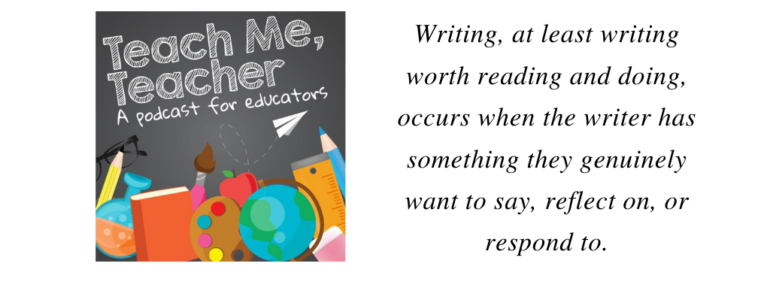By: Jacob Chastain
Quality writing does not happen in a vacuum. Likewise, it is not improved by endless and boring worksheets, grammar practice, and writing in isolation from in-authentic sources.
Writing, at least writing worth reading and doing, occurs when the writer has something they genuinely want to say, reflect on, or respond to. But how do writers gain the tools to do so? Many companies would like to tell you that a computer program (a modern-day workbook) is the solution. Just sit your students in front of a screen and have them correct sentences for thirty minutes a day and you too can have a writer who knows how to use a comma correctly! Teachers, ill-trained or supported in authentic practices accept these programs in the name of simplicity or mandates and move on. Meanwhile, they get to suffer as they read draft after draft of poor, lifeless writing from their students and lose faith over time that they can teach writing or that students can do it well.
The interesting piece to this scenario is that the teacher using such computer programs (or worksheets) to teach writing are often ignoring what they are doing in reading. In reading, this teacher probably looked at a section of a story, article, or poem, asked some questions, and quite possibly even analyzed language to some extent, looking for meaning. These are all solid teaching moves within reading, but why not use those in writing as well? Why create two separate lesson plans, when the first can serve both sides of what needs to happen in a literacy class?
Students should read like readers and read like writers. They should be tasked with experiencing the text and all that it offers, and then be challenged to look at it from a different perspective and ask the deep question, “How did the author do that?”
By just focusing on reading as a reader, we train students to be consumers of information, and never creators or synthesizers of it. We passively ask students to consider what the author was meaning when we could also offer for them to create their own meaning using the model in front of them.
Rather than just asking what the theme in a poem is, we can extend this to ask students how did the author convey that theme through language, symbols, and structure.
Rather than just asking what the argument of a piece was and if it was effective, we could ask what is the most effective way for them to argue for what they are passionate about.
Rather than just asking about text structures, we can invite them to try text structures we have seen to elevate their own pieces.
Rather than just looking at a beautiful sentence or paragraph and discussing it, we can ask our students to look at the craft of writing, the use of commas, periods, and dashes, and get them to see grammar as a tool for meaning, rather than punishment and nuisance.
If you are using great literature in your class, and we all should be, then the models are already there for you. Students don’t need worksheets, and you don’t need to be the greatest writer as their teacher. They need to see great writing in texts they can relate to, and you need to be equipped enough to be able to invite them into a multi-dimensional look at the examples all around them.
This approach creates deeper thinking in students. Over time, they begin reading in a way that is far more critical than a reader that has had a one-sided education. Rather than just consuming news, for example, they will now be able to distance themselves away from the material long enough to ask, “What was the author doing here? Why did they write this headline like this? What was the point of this structure?”
Teachers all over the world will bang their heads against the wall trying to get students to think about the author’s purpose and infer meanings in texts, but never offer students the chance to play those roles themselves and actually be the writer! It’s hard to grasp why someone might do something without ever stepping into their shoes. As students write more and think about their purpose for writing more, they will be able to read texts with more nuance and depth than they could previously.
Experience crafts deeper thinking.
Social media:
Facebook—Facebook.com/teachmeteacher
![]()













